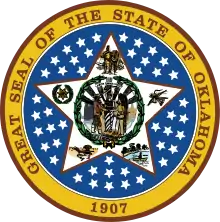Cimarron County, Oklahoma
Cimarron County is the westernmost county in the U.S. state of Oklahoma. Its county seat is Boise City.[1] As of the 2010 census, its population was 2,475,[2] making it the least-populous county in Oklahoma; and indeed, throughout most of its history, it has had both the smallest population and the lowest population density of any county in Oklahoma. Located in the Oklahoma Panhandle, Cimarron County contains the only community in the state (Kenton) that observes the Mountain Time Zone. Black Mesa, the highest point in the state, is in the northwest corner of the county. The Cimarron County community of Regnier has the distinction of being the driest spot in Oklahoma ranked by lowest annual average precipitation, at just 15.62 inches; but at the same time, Boise City is the snowiest location in Oklahoma ranked by highest annual average snowfall, at 31.6 inches.[3]
Cimarron County | |
|---|---|
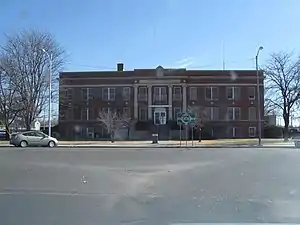 Cimarron County Courthouse in Boise City (2009) | |
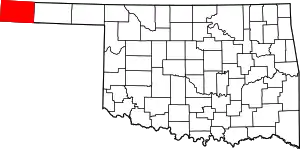 Location within the U.S. state of Oklahoma | |
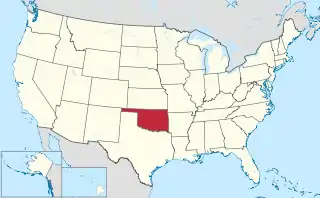 Oklahoma's location within the U.S. | |
| Coordinates: 36°44′N 102°31′W | |
| Country | |
| State | |
| Founded | 1907 |
| Seat | Boise City |
| Largest city | Boise City |
| Area | |
| • Total | 1,841 sq mi (4,770 km2) |
| • Land | 1,835 sq mi (4,750 km2) |
| • Water | 6.1 sq mi (16 km2) 0.3%% |
| Population (2010) | |
| • Total | 2,475 |
| • Estimate (2019) | 2,137 |
| • Density | 1.3/sq mi (0.5/km2) |
| Time zones | |
| entire county (legally) | UTC−6 (Central) |
| • Summer (DST) | UTC−5 (CDT) |
| Kenton (unofficially) | UTC−7 (Mountain) |
| • Summer (DST) | UTC−6 (MDT) |

History
Cimarron County was created at statehood in 1907. Before the Oklahoma Organic Act was passed in 1890, the area had belonged to what was known as "No-Man's Land", also referred to as the "Public Land Strip". This was a relatively lawless area, with no organized government, and several outlaws sought refuge within its borders. In 1890, the strip became known as Beaver County, Oklahoma Territory. Informally, it was known as the "Oklahoma Panhandle". Only two communities were in the strip. One, Carrizo (near present day Kenton),[4] had 83 residents in 1890, while the other, Mineral City, had 93 residents. Otherwise, the land was used primarily by sheepherders from New Mexico.[5]
Seven communities vied to become county seat after statehood: Boise City, Cimarron, Doby, Hurley, and Willowbar. A county election in 1908 selected Boise City.[5]
Railroads came late to this part of Oklahoma. The Elkhart and Santa Fe Railway built a line from Elkhart, Kansas, through Cimarron County in 1925. It completed the link into New Mexico in 1932. Service ended in 1942. The same company built a line from Colorado to Boise City in 1931 and extended it into Texas in 1937. This line still operates and in 2000 was part of the BNSF system.[5]
Geography

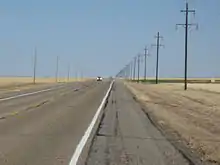
According to the U.S. Census Bureau, the county has a total area of 1,841 square miles (4,770 km2), of which 1,835 square miles (4,750 km2) are land and 6.1 square miles (16 km2) (0.3%) are covered by water.[6] It is the fourth-largest county in Oklahoma by area. It also has Oklahoma's highest point at 4,973 feet (1,516 m) above mean sea level on the Black Mesa.
The northern part of the county is drained by the Cimarron River, which flows eastward, then turns north into Kansas. The southern part is drained by the Beaver River (sometimes also called the North Canadian River). The man-made Lake Carl Etling lies inside Black Mesa Park.[5]
The Boise City Airport (FAA ID: 17K) is about 3 miles north of town.[7]
Major highways
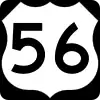 U.S. Highway 56
U.S. Highway 56 U.S. Highway 64
U.S. Highway 64 U.S. Highway 287
U.S. Highway 287 U.S. Highway 385
U.S. Highway 385 U.S. Highway 412
U.S. Highway 412 State Highway 3
State Highway 3 State Highway 171
State Highway 171 State Highway 325
State Highway 325
Adjacent states and counties
Cimarron County is the only county in the United States that borders four states: Colorado, Kansas, New Mexico, and Texas.[5] As a result, Cimarron County is the only county in the United States to border at least five counties from five different states (one from each of the four aforementioned states, plus one in Oklahoma and a second county in Texas).
- Baca County, Colorado (north/Mountain Time border)
- Morton County, Kansas (northeast)
- Texas County (east)
- Dallam County, Texas (south)
- Sherman County, Texas (southeast)
- Union County, New Mexico (west/Mountain Time border)
A location 300 yards (270 m) east of US 287-385 and 1.75 miles (2.82 km) south of the Cimarron River is the only place in the US less than 27 miles (43 km) from five different states: 26.99 miles (43.44 km) from Kansas, New Mexico, and Texas and 7 miles (11 km) from Colorado.[8]
National protected area
Demographics
| Historical population | |||
|---|---|---|---|
| Census | Pop. | %± | |
| 1910 | 4,553 | — | |
| 1920 | 3,436 | −24.5% | |
| 1930 | 5,408 | 57.4% | |
| 1940 | 3,054 | −43.5% | |
| 1950 | 4,589 | 50.3% | |
| 1960 | 4,496 | −2.0% | |
| 1970 | 4,145 | −7.8% | |
| 1980 | 3,648 | −12.0% | |
| 1990 | 3,301 | −9.5% | |
| 2000 | 3,148 | −4.6% | |
| 2010 | 2,475 | −21.4% | |
| 2019 (est.) | 2,137 | [9] | −13.7% |
| U.S. Decennial Census[10] 1790-1960[11] 1900-1990[12] 1990-2000[13] 2010-2019[2] | |||
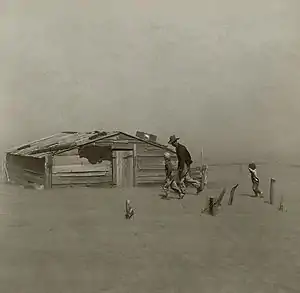
As of the 2010 census, 2,475 people, 1,047 households, and 705 families were residing in the county. The population density was 2 people per square mile (1/km2). The 1,587 housing units averaged 1 per square mile (0/km2). The racial makeup of the county was 84.7% White, 0.2% African American, 0.8% Native American, 0.3% Asian, 12.1% from other races, and 1.8% from two or more races. Hispanics or Latinos of any race made up 20.8% (16.4% Mexican, 1.4% Spanish, 0.2% Salvadoran).[15][16]
Of the 1,257 households, 31.30% had children under the age of 18 living with them, 60.40% were married couples living together, 6.00% had a female householder with no husband present, and 30.90% were not families. About 29.30% of all households were made up of individuals, and 15.50% had someone living alone who was 65 years of age or older. The average household size was 2.47, and the average family size was 3.07.
In the county, the age distribution was 27.60% under 18, 6.40% from 18 to 24, 23.40% from 25 to 44, 24.00% from 45 to 64, and 18.60% who were 65 years of age or older. The median age was 39 years. For every 100 females there were 97.40 males. For every 100 females age 18 and over, there were 95.30 males.
The median income for a household in the county was $30,625, and for a family was $36,250. Males had a median income of $24,327 versus $18,110 for females. The per capita income for the county was $15,744. About 13.90% of families and 17.60% of the population were below the poverty line, including 22.20% of those under age 18 and 10.10% of those age 65 or over.
Politics
Ninety-two percent of the voters in Cimarron County in the 2020 election cast their vote for the Republican candidate for president, Donald J. Trump, the highest percentage of any county in Oklahoma to vote for the Republican candidate. [17]
| Year | Republican | Democratic | Third parties |
|---|---|---|---|
| 2020 | 92.0% 970 | 6.7% 70 | 1.3% 14 |
| 2016 | 89.3% 963 | 6.6% 71 | 4.2% 45 |
| 2012 | 90.4% 1,082 | 9.6% 115 | |
| 2008 | 88.0% 1,119 | 12.0% 152 | |
| 2004 | 87.1% 1,242 | 12.9% 184 | |
| 2000 | 82.9% 1,230 | 15.3% 227 | 1.8% 27 |
| 1996 | 67.8% 986 | 24.8% 361 | 7.4% 108 |
| 1992 | 59.4% 965 | 24.3% 395 | 16.3% 264 |
| 1988 | 70.0% 1,153 | 28.5% 470 | 1.5% 24 |
| 1984 | 79.2% 1,420 | 20.0% 359 | 0.8% 15 |
| 1980 | 77.1% 1,404 | 20.5% 373 | 2.4% 44 |
| 1976 | 46.4% 872 | 51.2% 962 | 2.4% 45 |
| 1972 | 71.6% 1,350 | 17.1% 323 | 11.3% 212 |
| 1968 | 53.8% 1,122 | 20.9% 436 | 25.3% 527 |
| 1964 | 58.3% 1,225 | 41.8% 878 | |
| 1960 | 65.4% 1,316 | 34.6% 696 | |
| 1956 | 56.5% 1,053 | 43.5% 812 | |
| 1952 | 67.1% 1,438 | 32.9% 705 | |
| 1948 | 42.1% 650 | 57.9% 894 | |
| 1944 | 52.1% 822 | 47.3% 746 | 0.7% 11 |
| 1940 | 45.4% 841 | 53.4% 989 | 1.2% 23 |
| 1936 | 29.1% 555 | 70.3% 1,342 | 0.7% 13 |
| 1932 | 23.2% 571 | 76.9% 1,895 | |
| 1928 | 66.0% 1,139 | 32.8% 566 | 1.2% 20 |
| 1924 | 41.2% 586 | 47.3% 672 | 11.5% 164 |
| 1920 | 53.5% 630 | 39.5% 465 | 7.1% 83 |
| 1916 | 30.9% 238 | 50.2% 387 | 18.9% 146 |
| 1912 | 37.0% 263 | 48.2% 342 | 14.8% 105 |
| Voter Registration and Party Enrollment as of January 15, 2019[19] | |||||
|---|---|---|---|---|---|
| Party | Number of Voters | Percentage | |||
| Democratic | 347 | 21.61% | |||
| Republican | 1,103 | 68.68% | |||
| Others | 156 | 9.71% | |||
| Total | 1,606 | 100% | |||
Economy
The county economy has been largely based on cattle ranching and agriculture throughout its history. Wheat and grain sorghum are the most important crops. The Dust Bowl devastated the county during the 1930s, and the deluges of 1942-1945 destroyed what was left; the economy had to be completely rebuilt. Oil and natural gas production became important in the 1960s, and a gas plant near Keyes began producing helium in 1959. In 2000, Cimarron County had the ninth-highest per capita income of all Oklahoma counties.[5]
See also
References
- "Find a County". National Association of Counties. Archived from the original on May 31, 2011. Retrieved June 7, 2011.
- "State & County QuickFacts". United States Census Bureau. Archived from the original on July 8, 2011. Retrieved November 8, 2013.
- "Oklahoma Annual Rainfall and Climate Data". Coolweather.net. Retrieved November 29, 2020.
- "Oklahoma Panhandle: Badmen in No Man's Land". HistoryNet.com. Retrieved January 18, 2021.
- Young, Norma Gene. "Cimarron County," Encyclopedia of Oklahoma History and Culture, 2009. Accessed March 28, 2015.
- "2010 Census Gazetteer Files". United States Census Bureau. August 22, 2012. Retrieved February 18, 2015.
- "Boise City Airport". AirNav.com. Retrieved December 17, 2020.
- From United States Geological Survey sources, an area one mile southwest of Goshen, Massachusetts, is 27.3 miles (43.9 km) from five different states, second to this location.
- "County Population Totals: 2010-2019". Retrieved November 9, 2020.
- "U.S. Decennial Census". United States Census Bureau. Retrieved February 18, 2015.
- "Historical Census Browser". University of Virginia Library. Retrieved February 18, 2015.
- Forstall, Richard L., ed. (March 27, 1995). "Population of Counties by Decennial Census: 1900 to 1990". United States Census Bureau. Retrieved February 18, 2015.
- "Census 2000 PHC-T-4. Ranking Tables for Counties: 1990 and 2000" (PDF). United States Census Bureau. April 2, 2001. Retrieved February 18, 2015.
- Oklahoma's True Grit Dust Bowl Family, 77 Years Later; 405 Magazine.
- "Archived copy". Archived from the original on March 5, 2014. Retrieved May 15, 2016.CS1 maint: archived copy as title (link)
- "Archived copy". Archived from the original on December 18, 2014. Retrieved May 7, 2016.CS1 maint: archived copy as title (link)
- "Election Results: President: Oklahoma". CNN Politcs. CNN.
- Leip, David. "Dave Leip's Atlas of U.S. Presidential Elections". uselectionatlas.org. Retrieved March 28, 2018.
- "Oklahoma Registration Statistics by County" (PDF). OK.gov. January 15, 2019. Retrieved February 27, 2019.
Further reading
- Egan, Timothy (2006). The Worst Hard Time: The Untold Story of Those Who Survived the Great American Dust Bowl. Boston: Mariner Books. ISBN 0-618-34697-X. OCLC 58788898., includes much about the history of Cimarron County in the 20th century.
External links
| Wikimedia Commons has media related to Cimarron County, Oklahoma. |
